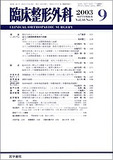Japanese
English
- 有料閲覧
- Abstract 文献概要
- 1ページ目 Look Inside
抄録:腰下肢症状を主訴に来院した1,090例を対象に,L4/5椎間で動的不安定性因子である前後への椎体動揺性と椎間可動角について,臨床症状との関連性を調査した.機能射側面X線像にて,椎体動揺度3mm以上,椎間可動角10°以上を不安定性ありとし,なし群も含めた4群間で比較した.結果は椎間可動角が10°以上の群は,10°未満の群に比べて有意に年齢が若く,若年者は椎間可動性が大きいと言えた.また3mm以上の椎体動揺度と10°以上の椎間可動角は,ともに臨床症状に影響する因子であった.さらに3mm以上の椎体動揺度は単独でも症状に影響を与えるが,10°以上の椎間可動角は単独では影響せず,椎体動揺性に合併した場合に症状を増強させる因子になると考えられた.
The relationship between radiological instability and clinical symptoms was examined in 1,090 outpatients with low back and/or leg pain. Sagittal translation and segmental angulation were measured on flexion-extension films, and symptoms in four groups, a group with and a group without 3mm translation, and a group with and a group without 10 degrees of angulation, were compared at the initial visit and at follow-up on the basis of the JOA score of the 1,090 patients and of age-matched patients. The results showed that patients with more than 10 degrees of angulation were significantly younger than those with less than 10 degrees of angulation, and the group with more than 3mm translation had significantly lower score than the less than 3mm translation group. However, no difference was observed between the group with more than 10 degrees of angulation and the group with less than 10 degrees of angulation. Patients with both more than 3mm translation and more than 10 degrees of angulation had the lowest score among the four groups at follow-up. This group had the longest history of low back and/or leg pain and had made more hospital visits than the other groups. In conclusion, having more than 3mm translation has a greater influence on lumbar symptoms than having more than 10 degrees of angulation. More than 10 degrees of angulation has no influence on lumbar symptoms itself, but it makes lumbar symptoms worse in combination with translation.

Copyright © 2003, Igaku-Shoin Ltd. All rights reserved.


